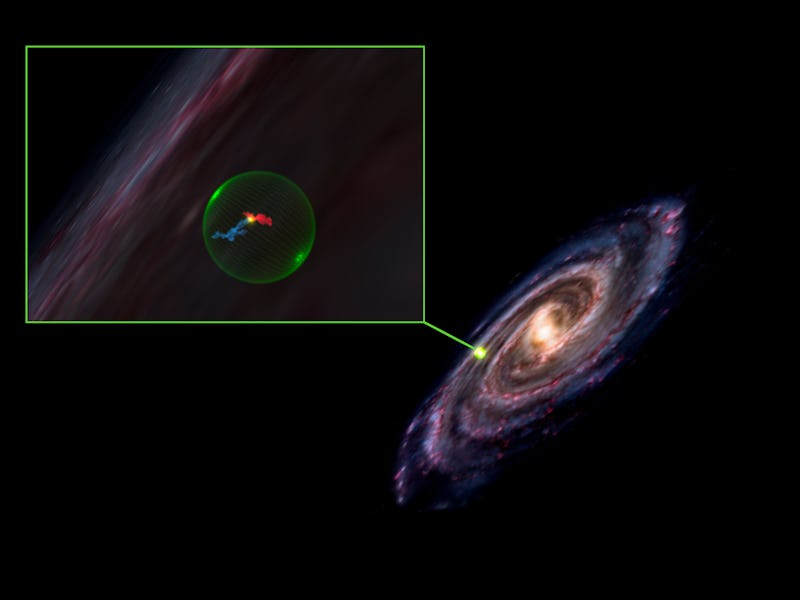A strange void found in space could solve an enduring mystery
This void spans across nearly 500 light years.

Shmuel Bialy had been mapping out a molecular cloud in the Milky Way for several years when he noticed something odd.
“We started looking at larger maps, building out the context of where this region is,” Bialy tells Inverse. “As we were zooming out, we finally saw this very huge cavity ... like a big ball surrounded by a shell.”
Bialy, an astrophysicist at the Center for Astrophysics | Harvard & Smithsonian and lead author of a paper detailing the latest findings, believes that this giant void in space was leftover from the aftermath of a supernova that took place 10 million years ago.
Although we think of supernovae as destructive events, this study suggests that this explosive end can lead to the birth of new stars.
Scientists had long theorized that supernova could create star-forming clouds, but this is the first observational data of its kind and provides astronomers a way to study one of these regions as it evolves.
The study was published Wednesday in the Astrophysical Journal Letters. The researchers have also published a 3D interactive model of the void.
WHAT’S NEW — The team observed the Perseus and Taurus molecular clouds, objects in the northern sky forming hundreds of new stars from giant clouds of dust and gas.
Using new data from Gaia — a space telescope launched by the European Space Agency — the astronomers obtained 3D maps of the molecular clouds. The 3D data allowed them to see the exact shape of the clouds and where they are in relation to one another.
Before, scientists thought the two clouds were located near each other. But the new data revealed a giant spherically-shaped void between them that spans 500 light years.
Although space is vast, it mostly teems with gas, dust, rocky objects, or stars. But this region wedged between the star-forming clouds was bare, puzzling the astronomers.
“What we see is the cavity, which means that there was some powerful mechanism to excavate this region,” Bialy says.
The data revealed that the Perseus and Taurus molecular clouds are not two independent structures but that they actually formed from the same event. And the scientists behind the new study believe that event may have been a supernova.
“That’s the most powerful of the different mechanisms,” Bialy says.
The two molecular clouds formed together from the same supernova around 10 million years ago, pushed further apart by the void in the event’s wake.
As stars near the end of their life, they collapse under the weight of their gravity. The star then explodes in a supernova, with the star’s material bursting out. The material left behind in the aftermath created clouds of dust and gas. Eventually, that material collapses to form new stars.
While astronomers theorized that these cavities existed, this is the first observation of one in space.
WHY IT MATTERS — Supernovae are often thought of as a cosmic apocalypse, laying waste to all that surrounds it with a deadly blast. This study suggests that these events could, in some cases, form clouds, which can go on to create stars.
“Supernovae are usually thought of as a negative process for cloud formation, with cloud formation being a very energetic phenomenon,” Bialy says. “Here we have a supernova that is actually helping the formation of clouds.”
These clouds give birth to young stars, but their own formation has always been a mystery.
“The question was, how do these cloud regions of high density that are responsible for star formation are formed,” he adds. “This observation kind of sheds light on the formation process.”
A picture of the Perseus Molecular Cloud, where new stars are being born.
WHAT’S NEXT — The recent observations not only shed light on an integral process that takes place across the universe, it also highlights a new way to view the cosmos.
Two-dimensional images only show a part of the story, but the new data by Gaia demonstrates that viewing objects in 3D offers the complete picture as though these objects had come to life.
Upcoming 3D observations of star-forming regions could confirm how these molecular clouds form and if a star’s end of life makes way for the birth of a new star.
Abstract — A major question in the field of star formation is how molecular clouds form out of the diffuse interstellar medium(ISM). Recent advances in 3D dust mapping are revolutionizing our view of the structure of the ISM. Using the highest-resolution 3D dust map to date, we explore the structure of a nearby star-forming region, which includes the well-known Perseus and Taurus molecular clouds. We reveal an extended near-spherical shell, 156 pc in diameter (hereafter called the “Per-Tau Shell”), in which the Perseus and Taurus clouds are embedded. We also find a large ring structure at the location of Taurus (hereafter called the “Tau Ring”). We discuss a formation scenario for the Per-Tau Shell, in which previous stellar and supernova feedback events formed a large expanding shell, where the swept-up ISM has condensed to form both the shell and the Perseus and Taurus molecular clouds within it. We present auxiliary observations of H I, Hα, 26Al, and X-rays that further support this scenario, and estimate the Per-Tau Shell’s age to be ≈6–22 Myrs. The Per-Tau shell offers the first 3D observational view of a phenomenon long-hypothesized theoretically, molecular cloud formation and star formation triggered by previous stellar and supernova feedback.
This article was originally published on